---
layout: default
title: Pose
parent: Solutions
nav_order: 5
---
# MediaPipe Pose
{: .no_toc }
Table of contents
{: .text-delta }
1. TOC
{:toc}
---
## Overview
Human pose estimation from video plays a critical role in various applications
such as
[quantifying physical exercises](#pose-classification-and-repetition-counting),
sign language recognition, and full-body gesture control. For example, it can
form the basis for yoga, dance, and fitness applications. It can also enable the
overlay of digital content and information on top of the physical world in
augmented reality.
MediaPipe Pose is a ML solution for high-fidelity body pose tracking, inferring
33 3D landmarks on the whole body (or 25 upper-body landmarks) from RGB video
frames utilizing our
[BlazePose](https://ai.googleblog.com/2020/08/on-device-real-time-body-pose-tracking.html)
research that also powers the
[ML Kit Pose Detection API](https://developers.google.com/ml-kit/vision/pose-detection).
Current state-of-the-art approaches rely primarily on powerful desktop
environments for inference, whereas our method achieves real-time performance on
most modern [mobile phones](#mobile), [desktops/laptops](#desktop), in
[python](#python-solution-api) and even on the [web](#javascript-solution-api).
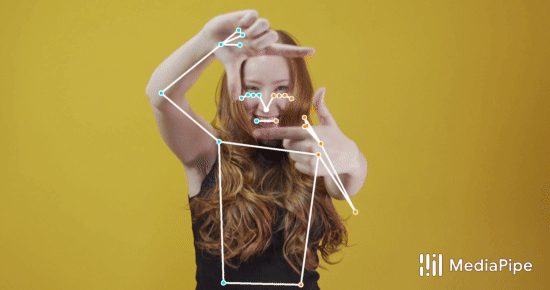 |
:--------------------------------------------------------------------------------------------: |
*Fig 1. Example of MediaPipe Pose for upper-body pose tracking.* |
## ML Pipeline
The solution utilizes a two-step detector-tracker ML pipeline, proven to be
effective in our [MediaPipe Hands](./hands.md) and
[MediaPipe Face Mesh](./face_mesh.md) solutions. Using a detector, the pipeline
first locates the person/pose region-of-interest (ROI) within the frame. The
tracker subsequently predicts the pose landmarks within the ROI using the
ROI-cropped frame as input. Note that for video use cases the detector is
invoked only as needed, i.e., for the very first frame and when the tracker
could no longer identify body pose presence in the previous frame. For other
frames the pipeline simply derives the ROI from the previous frame’s pose
landmarks.
The pipeline is implemented as a MediaPipe
[graph](https://github.com/google/mediapipe/tree/master/mediapipe/graphs/pose_tracking/pose_tracking_gpu.pbtxt)
that uses a
[pose landmark subgraph](https://github.com/google/mediapipe/tree/master/mediapipe/modules/pose_landmark/pose_landmark_gpu.pbtxt)
from the
[pose landmark module](https://github.com/google/mediapipe/tree/master/mediapipe/modules/pose_landmark)
and renders using a dedicated
[pose renderer subgraph](https://github.com/google/mediapipe/tree/master/mediapipe/graphs/pose_tracking/subgraphs/pose_renderer_gpu.pbtxt).
The
[pose landmark subgraph](https://github.com/google/mediapipe/tree/master/mediapipe/modules/pose_landmark/pose_landmark_gpu.pbtxt)
internally uses a
[pose detection subgraph](https://github.com/google/mediapipe/tree/master/mediapipe/modules/pose_detection/pose_detection_gpu.pbtxt)
from the
[pose detection module](https://github.com/google/mediapipe/tree/master/mediapipe/modules/pose_detection).
Note: To visualize a graph, copy the graph and paste it into
[MediaPipe Visualizer](https://viz.mediapipe.dev/). For more information on how
to visualize its associated subgraphs, please see
[visualizer documentation](../tools/visualizer.md).
## Models
### Person/pose Detection Model (BlazePose Detector)
The detector is inspired by our own lightweight
[BlazeFace](https://arxiv.org/abs/1907.05047) model, used in
[MediaPipe Face Detection](./face_detection.md), as a proxy for a person
detector. It explicitly predicts two additional virtual keypoints that firmly
describe the human body center, rotation and scale as a circle. Inspired by
[Leonardo’s Vitruvian man](https://en.wikipedia.org/wiki/Vitruvian_Man), we
predict the midpoint of a person's hips, the radius of a circle circumscribing
the whole person, and the incline angle of the line connecting the shoulder and
hip midpoints.
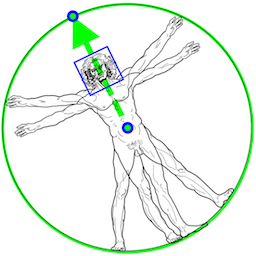 |
:----------------------------------------------------------------------------------------------------: |
*Fig 2. Vitruvian man aligned via two virtual keypoints predicted by BlazePose detector in addition to the face bounding box.* |
### Pose Landmark Model (BlazePose GHUM 3D)
The landmark model in MediaPipe Pose comes in two versions: a full-body model
that predicts the location of 33 pose landmarks (see figure below), and an
upper-body version that only predicts the first 25. The latter may be more
accurate than the former in scenarios where the lower-body parts are mostly out
of view.
Please find more detail in the
[BlazePose Google AI Blog](https://ai.googleblog.com/2020/08/on-device-real-time-body-pose-tracking.html),
this [paper](https://arxiv.org/abs/2006.10204) and
[the model card](./models.md#pose), and the attributes in each landmark
[below](#pose_landmarks).
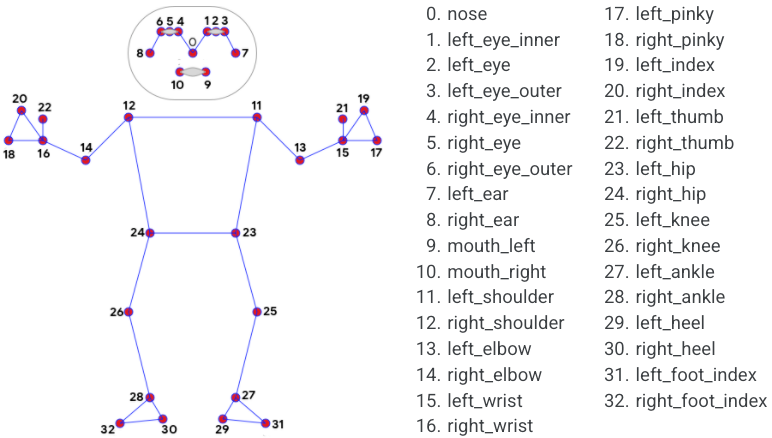 |
:----------------------------------------------------------------------------------------------: |
*Fig 3. 33 pose landmarks.* |
## Solution APIs
### Cross-platform Configuration Options
Naming style and availability may differ slightly across platforms/languages.
#### static_image_mode
If set to `false`, the solution treats the input images as a video stream. It
will try to detect the most prominent person in the very first images, and upon
a successful detection further localizes the pose landmarks. In subsequent
images, it then simply tracks those landmarks without invoking another detection
until it loses track, on reducing computation and latency. If set to `true`,
person detection runs every input image, ideal for processing a batch of static,
possibly unrelated, images. Default to `false`.
#### upper_body_only
If set to `true`, the solution outputs only the 25 upper-body pose landmarks.
Otherwise, it outputs the full set of 33 pose landmarks. Note that
upper-body-only prediction may be more accurate for use cases where the
lower-body parts are mostly out of view. Default to `false`.
#### smooth_landmarks
If set to `true`, the solution filters pose landmarks across different input
images to reduce jitter, but ignored if [static_image_mode](#static_image_mode)
is also set to `true`. Default to `true`.
#### min_detection_confidence
Minimum confidence value (`[0.0, 1.0]`) from the person-detection model for the
detection to be considered successful. Default to `0.5`.
#### min_tracking_confidence
Minimum confidence value (`[0.0, 1.0]`) from the landmark-tracking model for the
pose landmarks to be considered tracked successfully, or otherwise person
detection will be invoked automatically on the next input image. Setting it to a
higher value can increase robustness of the solution, at the expense of a higher
latency. Ignored if [static_image_mode](#static_image_mode) is `true`, where
person detection simply runs on every image. Default to `0.5`.
### Output
Naming style may differ slightly across platforms/languages.
#### pose_landmarks
A list of pose landmarks. Each lanmark consists of the following:
* `x` and `y`: Landmark coordinates normalized to `[0.0, 1.0]` by the image
width and height respectively.
* `z`: Represents the landmark depth with the depth at the midpoint of hips
being the origin, and the smaller the value the closer the landmark is to
the camera. The magnitude of `z` uses roughly the same scale as `x`.
Note: `z` is predicted only in full-body mode, and should be discarded when
[upper_body_only](#upper_body_only) is `true`.
* `visibility`: A value in `[0.0, 1.0]` indicating the likelihood of the
landmark being visible (present and not occluded) in the image.
### Python Solution API
Please first follow general [instructions](../getting_started/python.md) to
install MediaPipe Python package, then learn more in the companion
[Python Colab](#resources) and the following usage example.
Supported configuration options:
* [static_image_mode](#static_image_mode)
* [upper_body_only](#upper_body_only)
* [smooth_landmarks](#smooth_landmarks)
* [min_detection_confidence](#min_detection_confidence)
* [min_tracking_confidence](#min_tracking_confidence)
```python
import cv2
import mediapipe as mp
mp_drawing = mp.solutions.drawing_utils
mp_pose = mp.solutions.pose
# For static images:
with mp_pose.Pose(
static_image_mode=True, min_detection_confidence=0.5) as pose:
for idx, file in enumerate(file_list):
image = cv2.imread(file)
image_height, image_width, _ = image.shape
# Convert the BGR image to RGB before processing.
results = pose.process(cv2.cvtColor(image, cv2.COLOR_BGR2RGB))
if not results.pose_landmarks:
continue
print(
f'Nose coordinates: ('
f'{results.pose_landmarks.landmark[mp_holistic.PoseLandmark.NOSE].x * image_width}, '
f'{results.pose_landmarks.landmark[mp_holistic.PoseLandmark.NOSE].y * image_height})'
)
# Draw pose landmarks on the image.
annotated_image = image.copy()
# Use mp_pose.UPPER_BODY_POSE_CONNECTIONS for drawing below when
# upper_body_only is set to True.
mp_drawing.draw_landmarks(
annotated_image, results.pose_landmarks, mp_pose.POSE_CONNECTIONS)
cv2.imwrite('/tmp/annotated_image' + str(idx) + '.png', annotated_image)
# For webcam input:
cap = cv2.VideoCapture(0)
with mp_pose.Pose(
min_detection_confidence=0.5,
min_tracking_confidence=0.5) as pose:
while cap.isOpened():
success, image = cap.read()
if not success:
print("Ignoring empty camera frame.")
# If loading a video, use 'break' instead of 'continue'.
continue
# Flip the image horizontally for a later selfie-view display, and convert
# the BGR image to RGB.
image = cv2.cvtColor(cv2.flip(image, 1), cv2.COLOR_BGR2RGB)
# To improve performance, optionally mark the image as not writeable to
# pass by reference.
image.flags.writeable = False
results = pose.process(image)
# Draw the pose annotation on the image.
image.flags.writeable = True
image = cv2.cvtColor(image, cv2.COLOR_RGB2BGR)
mp_drawing.draw_landmarks(
image, results.pose_landmarks, mp_pose.POSE_CONNECTIONS)
cv2.imshow('MediaPipe Pose', image)
if cv2.waitKey(5) & 0xFF == 27:
break
cap.release()
```
### JavaScript Solution API
Please first see general [introduction](../getting_started/javascript.md) on
MediaPipe in JavaScript, then learn more in the companion [web demo](#resources)
and the following usage example.
Supported configuration options:
* [upperBodyOnly](#upper_body_only)
* [smoothLandmarks](#smooth_landmarks)
* [minDetectionConfidence](#min_detection_confidence)
* [minTrackingConfidence](#min_tracking_confidence)
```html
```
```javascript
```
## Example Apps
Please first see general instructions for
[Android](../getting_started/android.md), [iOS](../getting_started/ios.md), and
[desktop](../getting_started/cpp.md) on how to build MediaPipe examples.
Note: To visualize a graph, copy the graph and paste it into
[MediaPipe Visualizer](https://viz.mediapipe.dev/). For more information on how
to visualize its associated subgraphs, please see
[visualizer documentation](../tools/visualizer.md).
### Mobile
#### Main Example
* Graph:
[`mediapipe/graphs/pose_tracking/pose_tracking_gpu.pbtxt`](https://github.com/google/mediapipe/tree/master/mediapipe/graphs/pose_tracking/pose_tracking_gpu.pbtxt)
* Android target:
[(or download prebuilt ARM64 APK)](https://drive.google.com/file/d/17GFIrqEJS6W8UHKXlYevTtSCLxN9pWlY/view?usp=sharing)
[`mediapipe/examples/android/src/java/com/google/mediapipe/apps/posetrackinggpu:posetrackinggpu`](https://github.com/google/mediapipe/tree/master/mediapipe/examples/android/src/java/com/google/mediapipe/apps/posetrackinggpu/BUILD)
* iOS target:
[`mediapipe/examples/ios/posetrackinggpu:PoseTrackingGpuApp`](http:/mediapipe/examples/ios/posetrackinggpu/BUILD)
#### Upper-body Only
* Graph:
[`mediapipe/graphs/pose_tracking/upper_body_pose_tracking_gpu.pbtxt`](https://github.com/google/mediapipe/tree/master/mediapipe/graphs/pose_tracking/upper_body_pose_tracking_gpu.pbtxt)
* Android target:
[(or download prebuilt ARM64 APK)](https://drive.google.com/file/d/1uKc6T7KSuA0Mlq2URi5YookHu0U3yoh_/view?usp=sharing)
[`mediapipe/examples/android/src/java/com/google/mediapipe/apps/upperbodyposetrackinggpu:upperbodyposetrackinggpu`](https://github.com/google/mediapipe/tree/master/mediapipe/examples/android/src/java/com/google/mediapipe/apps/upperbodyposetrackinggpu/BUILD)
* iOS target:
[`mediapipe/examples/ios/upperbodyposetrackinggpu:UpperBodyPoseTrackingGpuApp`](http:/mediapipe/examples/ios/upperbodyposetrackinggpu/BUILD)
### Desktop
Please first see general instructions for [desktop](../getting_started/cpp.md)
on how to build MediaPipe examples.
#### Main Example
* Running on CPU
* Graph:
[`mediapipe/graphs/pose_tracking/pose_tracking_cpu.pbtxt`](https://github.com/google/mediapipe/tree/master/mediapipe/graphs/pose_tracking/pose_tracking_cpu.pbtxt)
* Target:
[`mediapipe/examples/desktop/pose_tracking:pose_tracking_cpu`](https://github.com/google/mediapipe/tree/master/mediapipe/examples/desktop/pose_tracking/BUILD)
* Running on GPU
* Graph:
[`mediapipe/graphs/pose_tracking/pose_tracking_gpu.pbtxt`](https://github.com/google/mediapipe/tree/master/mediapipe/graphs/pose_tracking/pose_tracking_gpu.pbtxt)
* Target:
[`mediapipe/examples/desktop/pose_tracking:pose_tracking_gpu`](https://github.com/google/mediapipe/tree/master/mediapipe/examples/desktop/pose_tracking/BUILD)
#### Upper-body Only
* Running on CPU
* Graph:
[`mediapipe/graphs/pose_tracking/upper_body_pose_tracking_cpu.pbtxt`](https://github.com/google/mediapipe/tree/master/mediapipe/graphs/pose_tracking/upper_body_pose_tracking_cpu.pbtxt)
* Target:
[`mediapipe/examples/desktop/upper_body_pose_tracking:upper_body_pose_tracking_cpu`](https://github.com/google/mediapipe/tree/master/mediapipe/examples/desktop/upper_body_pose_tracking/BUILD)
* Running on GPU
* Graph:
[`mediapipe/graphs/pose_tracking/upper_body_pose_tracking_gpu.pbtxt`](https://github.com/google/mediapipe/tree/master/mediapipe/graphs/pose_tracking/upper_body_pose_tracking_gpu.pbtxt)
* Target:
[`mediapipe/examples/desktop/upper_body_pose_tracking:upper_body_pose_tracking_gpu`](https://github.com/google/mediapipe/tree/master/mediapipe/examples/desktop/upper_body_pose_tracking/BUILD)
## Pose Classification and Repetition Counting
One of the applications
[BlazePose](https://ai.googleblog.com/2020/08/on-device-real-time-body-pose-tracking.html)
can enable is fitness. More specifically - pose classification and repetition
counting. In this section we'll provide basic guidance on building a custom pose
classifier with the help of a
[Colab](https://drive.google.com/file/d/19txHpN8exWhstO6WVkfmYYVC6uug_oVR/view?usp=sharing)
and wrap it in a simple
[fitness app](https://mediapipe.page.link/mlkit-pose-classification-demo-app)
powered by [ML Kit](https://developers.google.com/ml-kit). Push-ups and squats
are used for demonstration purposes as the most common exercises.
 |
:--------------------------------------------------------------------------------------------------------: |
*Fig 4. Pose classification and repetition counting with MediaPipe Pose.* |
We picked the
[k-nearest neighbors algorithm](https://en.wikipedia.org/wiki/K-nearest_neighbors_algorithm)
(k-NN) as the classifier. It's simple and easy to start with. The algorithm
determines the object's class based on the closest samples in the training set.
To build it, one needs to:
* Collect image samples of the target exercises and run pose prediction on
them,
* Convert obtained pose landmarks to a representation suitable for the k-NN
classifier and form a training set,
* Perform the classification itself followed by repetition counting.
### Training Set
To build a good classifier appropriate samples should be collected for the
training set: about a few hundred samples for each terminal state of each
exercise (e.g., "up" and "down" positions for push-ups). It's important that
collected samples cover different camera angles, environment conditions, body
shapes, and exercise variations.
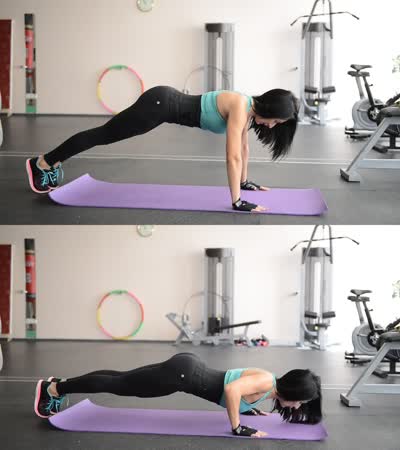 |
:--------------------------------------------------------------------------------------------------------------------------: |
*Fig 5. Two terminal states of push-ups.* |
To transform samples into a k-NN classifier training set, either
[basic](https://drive.google.com/file/d/1z4IM8kG6ipHN6keadjD-F6vMiIIgViKK/view?usp=sharing)
or
[extended](https://drive.google.com/file/d/19txHpN8exWhstO6WVkfmYYVC6uug_oVR/view?usp=sharing)
Colab could be used. They both use the
[Python Solution API](#python-solution-api) to run the BlazePose models on given
images and dump predicted pose landmarks to a CSV file. Additionally, the
extended Colab provides useful tools to find outliers (e.g., wrongly predicted
poses) and underrepresented classes (e.g., not covering all camera angles) by
classifying each sample against the entire training set. After that, you'll be
able to test the classifier on an arbitrary video right in the Colab.
### Classification
Code of the classifier is available both in the
[extended](https://drive.google.com/file/d/19txHpN8exWhstO6WVkfmYYVC6uug_oVR/view?usp=sharing)
Colab and in the
[ML Kit demo app](https://mediapipe.page.link/mlkit-pose-classification-demo-app).
Please refer to them for details of the approach described below.
The k-NN algorithm used for pose classification requires a feature vector
representation of each sample and a metric to compute the distance between two
such vectors to find the nearest pose samples to a target one.
To convert pose landmarks to a feature vector, we use pairwise distances between
predefined lists of pose joints, such as distances between wrist and shoulder,
ankle and hip, and two wrists. Since the algorithm relies on distances, all
poses are normalized to have the same torso size and vertical torso orientation
before the conversion.
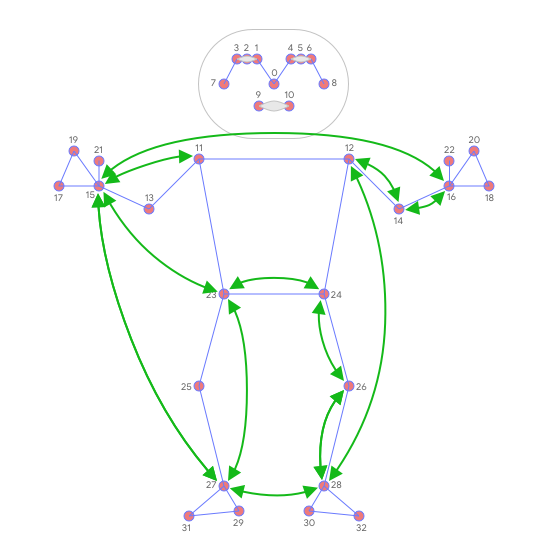 |
:--------------------------------------------------------------------------------------------------------: |
*Fig 6. Main pairwise distances used for the pose feature vector.* |
To get a better classification result, k-NN search is invoked twice with
different distance metrics:
* First, to filter out samples that are almost the same as the target one but
have only a few different values in the feature vector (which means
differently bent joints and thus other pose class), minimum per-coordinate
distance is used as distance metric,
* Then average per-coordinate distance is used to find the nearest pose
cluster among those from the first search.
Finally, we apply
[exponential moving average](https://en.wikipedia.org/wiki/Moving_average#Exponential_moving_average)
(EMA) smoothing to level any noise from pose prediction or classification. To do
that, we search not only for the nearest pose cluster, but we calculate a
probability for each of them and use it for smoothing over time.
### Repetition Counter
To count the repetitions, the algorithm monitors the probability of a target
pose class. Let's take push-ups with its "up" and "down" terminal states:
* When the probability of the "down" pose class passes a certain threshold for
the first time, the algorithm marks that the "down" pose class is entered.
* Once the probability drops below the threshold, the algorithm marks that the
"down" pose class has been exited and increases the counter.
To avoid cases when the probability fluctuates around the threshold (e.g., when
the user pauses between "up" and "down" states) causing phantom counts, the
threshold used to detect when the state is exited is actually slightly lower
than the one used to detect when the state is entered. It creates an interval
where the pose class and the counter can't be changed.
### Future Work
We are actively working on improving BlazePose GHUM 3D's Z prediction. It will
allow us to use joint angles in the feature vectors, which are more natural and
easier to configure (although distances can still be useful to detect touches
between body parts) and to perform rotation normalization of poses and reduce
the number of camera angles required for accurate k-NN classification.
## Resources
* Google AI Blog:
[BlazePose - On-device Real-time Body Pose Tracking](https://ai.googleblog.com/2020/08/on-device-real-time-body-pose-tracking.html)
* Paper:
[BlazePose: On-device Real-time Body Pose Tracking](https://arxiv.org/abs/2006.10204)
([presentation](https://youtu.be/YPpUOTRn5tA))
* [Models and model cards](./models.md#pose)
* [Web demo](https://code.mediapipe.dev/codepen/pose)
* [Python Colab](https://mediapipe.page.link/pose_py_colab)
* [Pose Classification Colab (Basic)](https://mediapipe.page.link/pose_classification_basic)
* [Pose Classification Colab (Extended)](https://mediapipe.page.link/pose_classification_extended)